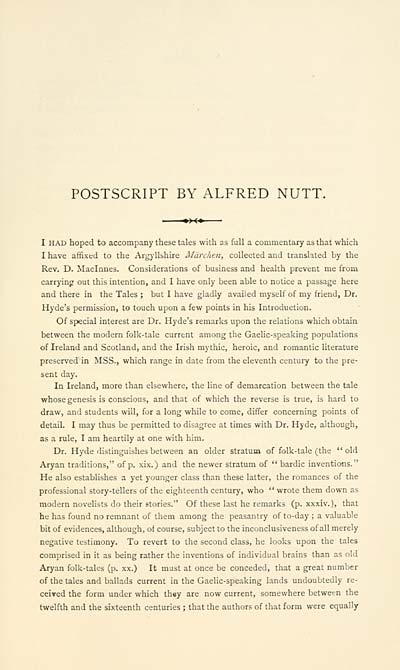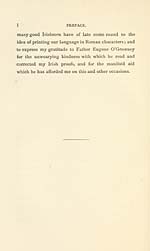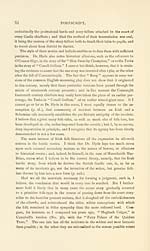Blair Collection > Beside the fire
(55)
Download files
Complete book:
Individual page:
Thumbnail gallery: Grid view | List view

POSTSCRIPT BY ALFRED NUTT.
I HAD hoped to accompany these tales with as full a commentary as that which
I have affixed to the Arg}'llshire Mdrchen, collected and translated by the
Rev. D. Maclnues. Considerations of business and health prevent me from
carrying out this intention, and I have only been able to notice a passage here
and there in the Tales ; but I have gladly availed myself of my friend, Dr.
Hyde's permission, to touch upon a few points in his Introduction.
Of special interest are Dr. Hyde's remarks upon the relations which obtain
between the modern folk-tale current among the Gaelic-speaking populations
of Ireland and Scotland, and the Irish mythic, heroic, and romantic literature
preserved' in MSS., which range in date from the eleventh century to the pre-
sent day.
In Ireland, more than elsewhere, the line of demarcation between the tale
whose genesis is conscious, and that of which the reverse is true, is hard to
draw, and students will, for a long while to come, differ concerning points of
detail. I may thus be permitted to disagree at times with Dr. Hyde, although,
as a rule, I am heartily at one with him.
Dr. Hyde distinguishes between an older stratum of folk-tale (the "old
Aryan traditions," of p. xix.) and the newer stratum of " bardic inventions."
He also establishes a yet younger class than these latter, the romances of the
professional story-tellers of the eighteenth century, who " wrote them down as
modern novelists do their stories." Of these last he remarks (p. xxxiv.), that
he has found no remnant of them among the peasantry of to-day ; a valuable
bit of evidences, although, of course, subject to the inconclusiveness of all merely
negative testimony. To revert to the second class, he looks upon the tales
comprised in it as being rather the inventions of individual brains than as old
Aryan folk-tales (p. xx.) It must at once be conceded, that a great number
of the tales and ballads current in the Gaelic-speaking lands undoubtedly re-
ceived the form under which they are now current, somewhere between the
twelfth and the sixteenth centuries ; that the authors of that form were equally
I HAD hoped to accompany these tales with as full a commentary as that which
I have affixed to the Arg}'llshire Mdrchen, collected and translated by the
Rev. D. Maclnues. Considerations of business and health prevent me from
carrying out this intention, and I have only been able to notice a passage here
and there in the Tales ; but I have gladly availed myself of my friend, Dr.
Hyde's permission, to touch upon a few points in his Introduction.
Of special interest are Dr. Hyde's remarks upon the relations which obtain
between the modern folk-tale current among the Gaelic-speaking populations
of Ireland and Scotland, and the Irish mythic, heroic, and romantic literature
preserved' in MSS., which range in date from the eleventh century to the pre-
sent day.
In Ireland, more than elsewhere, the line of demarcation between the tale
whose genesis is conscious, and that of which the reverse is true, is hard to
draw, and students will, for a long while to come, differ concerning points of
detail. I may thus be permitted to disagree at times with Dr. Hyde, although,
as a rule, I am heartily at one with him.
Dr. Hyde distinguishes between an older stratum of folk-tale (the "old
Aryan traditions," of p. xix.) and the newer stratum of " bardic inventions."
He also establishes a yet younger class than these latter, the romances of the
professional story-tellers of the eighteenth century, who " wrote them down as
modern novelists do their stories." Of these last he remarks (p. xxxiv.), that
he has found no remnant of them among the peasantry of to-day ; a valuable
bit of evidences, although, of course, subject to the inconclusiveness of all merely
negative testimony. To revert to the second class, he looks upon the tales
comprised in it as being rather the inventions of individual brains than as old
Aryan folk-tales (p. xx.) It must at once be conceded, that a great number
of the tales and ballads current in the Gaelic-speaking lands undoubtedly re-
ceived the form under which they are now current, somewhere between the
twelfth and the sixteenth centuries ; that the authors of that form were equally
Set display mode to: Large image | Transcription
Images and transcriptions on this page, including medium image downloads, may be used under the Creative Commons Attribution 4.0 International Licence unless otherwise stated. ![]()
| Early Gaelic Book Collections > Blair Collection > Beside the fire > (55) |
|---|
| Permanent URL | https://digital.nls.uk/76244300 |
|---|
| Description | A collection of Irish Gaelic folk stories. |
|---|---|
| Shelfmark | Blair.222 |
| Additional NLS resources: | |
| Attribution and copyright: |
|
| Description | A selection of books from a collection of more than 500 titles, mostly on religious and literary topics. Also includes some material dealing with other Celtic languages and societies. Collection created towards the end of the 19th century by Lady Evelyn Stewart Murray. |
|---|
| Description | Selected items from five 'Special and Named Printed Collections'. Includes books in Gaelic and other Celtic languages, works about the Gaels, their languages, literature, culture and history. |
|---|

